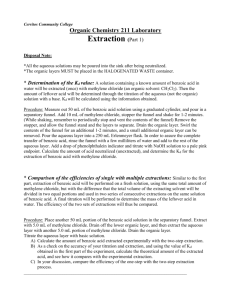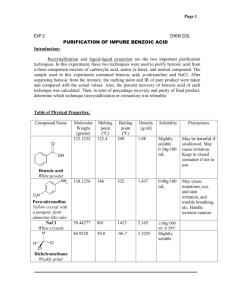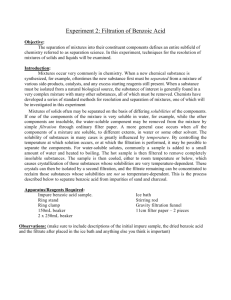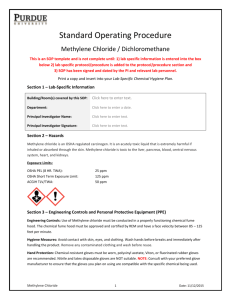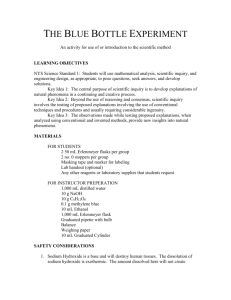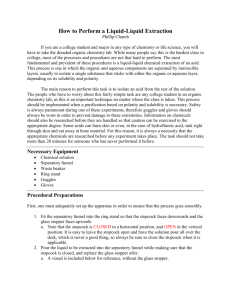Extraction Of Benzoic Acid From Naphthalene
advertisement
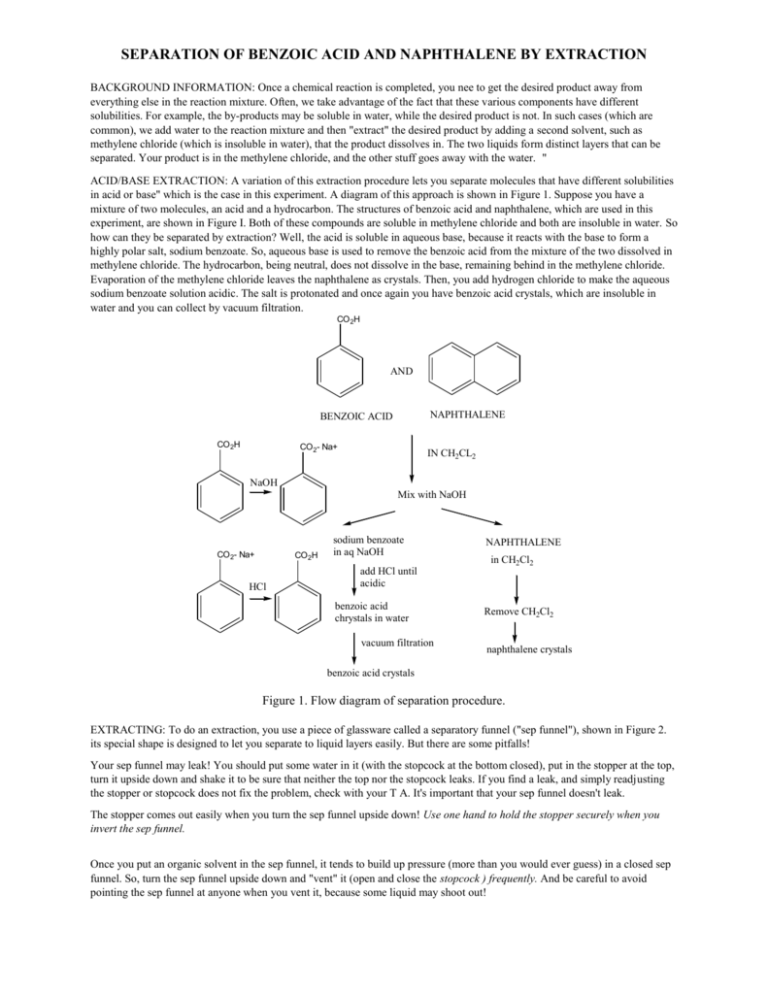
SEPARATION OF BENZOIC ACID AND NAPHTHALENE BY EXTRACTION BACKGROUND INFORMATION: Once a chemical reaction is completed, you nee to get the desired product away from everything else in the reaction mixture. Often, we take advantage of the fact that these various components have different solubilities. For example, the by-products may be soluble in water, while the desired product is not. In such cases (which are common), we add water to the reaction mixture and then "extract" the desired product by adding a second solvent, such as methylene chloride (which is insoluble in water), that the product dissolves in. The two liquids form distinct layers that can be separated. Your product is in the methylene chloride, and the other stuff goes away with the water. " ACID/BASE EXTRACTION: A variation of this extraction procedure lets you separate molecules that have different solubilities in acid or base" which is the case in this experiment. A diagram of this approach is shown in Figure 1. Suppose you have a mixture of two molecules, an acid and a hydrocarbon. The structures of benzoic acid and naphthalene, which are used in this experiment, are shown in Figure I. Both of these compounds are soluble in methylene chloride and both are insoluble in water. So how can they be separated by extraction? Well, the acid is soluble in aqueous base, because it reacts with the base to form a highly polar salt, sodium benzoate. So, aqueous base is used to remove the benzoic acid from the mixture of the two dissolved in methylene chloride. The hydrocarbon, being neutral, does not dissolve in the base, remaining behind in the methylene chloride. Evaporation of the methylene chloride leaves the naphthalene as crystals. Then, you add hydrogen chloride to make the aqueous sodium benzoate solution acidic. The salt is protonated and once again you have benzoic acid crystals, which are insoluble in water and you can collect by vacuum filtration. CO 2H AND NAPHTHALENE BENZOIC ACID CO 2H CO 2- Na+ IN CH2CL2 NaOH Mix with NaOH CO 2- Na+ CO 2H HCl sodium benzoate in aq NaOH NAPHTHALENE in CH2Cl2 add HCl until acidic benzoic acid chrystals in water vacuum filtration Remove CH2Cl2 naphthalene crystals benzoic acid crystals Figure 1. Flow diagram of separation procedure. EXTRACTING: To do an extraction, you use a piece of glassware called a separatory funnel ("sep funnel"), shown in Figure 2. its special shape is designed to let you separate to liquid layers easily. But there are some pitfalls! Your sep funnel may leak! You should put some water in it (with the stopcock at the bottom closed), put in the stopper at the top, turn it upside down and shake it to be sure that neither the top nor the stopcock leaks. If you find a leak, and simply readjusting the stopper or stopcock does not fix the problem, check with your T A. It's important that your sep funnel doesn't leak. The stopper comes out easily when you turn the sep funnel upside down! Use one hand to hold the stopper securely when you invert the sep funnel. Once you put an organic solvent in the sep funnel, it tends to build up pressure (more than you would ever guess) in a closed sep funnel. So, turn the sep funnel upside down and "vent" it (open and close the stopcock ) frequently. And be careful to avoid pointing the sep funnel at anyone when you vent it, because some liquid may shoot out! It's easy - too easy - to forget to close the stopcock before you pour in your solution with your product in it. This mistake is costly -- You clean up the mess and start over! When two immiscible liquids are shaken together (as required for extraction), they tend to form an emulsion - the two liquids get caught up in each other and fail to separate. Emulsions can be easy - or very difficult --to "break". If an emulsion forms in your sep funnel, check with your T A to see what you should do. To help avoid forming an emulsion, shake the funnel enough to mix the layers but not too vigorously. Figure 2. Use of a separatory funnel PURIFYING THE PRODUCT: Once you have separated the components of a mixture by extraction, you may find they are not completely pure; to complete the purification, solids can be recrystallized and liquids can be distilled or purified by column chromatography. Safety Notes! Hydrochloric acid and sodium hydroxide are corrosive and can cause burns. Use great care to avoid contact with skin, eyes, and clothing. Wear rubber gloves! In case of accidental contact, flood the affected area with copious amounts of water and seek medical attention. Spills should be diluted with water and cleaned up immediately. Methylene chloride is toxic and is classified as a carcinogen, and must be used in well-ventilated space only. All materials must be discarded in the containers provided. Procedure Place approximately I g of benzoic acid (weigh and record the weight to two decimal places) and approximately I g of naphthalene (weigh and record the weight to two decimal places) in a 100 mL Erlenmeyer flask, add 30 mL of methylene chloride, and swirl to dissolve. Warm gently to speed up dissolution. Once all the mixture has dissolved, pour the solution into your sep funnel. Note! Check to see that the stopcock or your sep funnel is closed. Use 10 mL of methylene chloride to rinse the Erlenmeyer flask and add this 10 mL to the sep funnel. Add 15 mL of 10% aqueous sodium hydroxide, shake well to mix the two layers, frequently inverting and venting the sep funnel to release the pressure that builds up, and then place the sep funnel in a ring stand to allow the layers to separate. Once they are separated, drain the bottom (methylene chloride) layer slowly into the original Erlenmeyer flask and close the stopcock. Swirl the sep funnel to get any remaining methylene chloride to the bottom, and drain it into the methylene chloride solution. Allow a very small amount of the aqueous layer to go through the stopcock. Pour the remaining (aqueous) layer out the top of the sep funnel into a clean Erlenmeyer flask. To extract a second time, pour the methylene chloride solution back into the sep funnel, again add 15 mL of 10% aqueous sodium hydroxide and repeat the extraction procedure as described in the paragraph above. Add this second aqueous extract to the first. Repeat once more. This third time, be careful to avoid allowing any aqueous solution pass through the stopcock. Add this third aqueous extract to the other container containing the other two. The resulting methylene chloride solution should have very little water in it. If you can see drops (or more) of water, either pour off the solution into a clean, dry Erlenmeyer flask leaving the water behind, or use the sep funnel to separate the water from your methylene chloride solution. When the visible water is gone, add" anhydrous sodium sulfate, a small amount at a time, to the methylene chloride solution to remove what little water has dissolved in the methylene chloride. Swirl the mixture to speed up the drying. Add more anhydrous sodium sulfate - in small portions - if all the solid in the flask clumps together. Add enough so that some moves freely when you swirl the solution in the flask. (Like those little toys that show snow scenes in a tiny globe.) Once the solution is dry, filter it through a standard filter funnel that has a small cotton plug in it. Collect the dry (It's a liquid, but it has no water.) solution in a "tared" (You must know the weight of this flask.) 100 mL round-bottom flask and remove. the methylene chloride using a rotary evaporator. Weigh the flask to obtain the weight of the crystals, determine their melting point, and determine the melting range of a mixture of these crystals mixed with naphthalene. Now return to the flask that contains your combined aqueous (basic) extracts containing sodium benzoate. To this solution, add, with stirring, 6 N hydrochloric acid until pH paper indicates that the solution is acidic. You should see crystals of benzoic acid. Collect the resulting crystals using vacuum filtration. Stop the vacuum, add 5 mL of water, stir gently to wash the crystals without disturbing the filter paper, and remove this wash water using the vacuum. Repeat the washing procedure until the water that comes through the funnel is no longer acidic. Then pull air through the crystals using the vacuum to dry them. Weigh the dried crystals, determine their melting point, and determine the melting range of a mixture of these crystals mixed with benzoic acid. Clean up Discard your product, all solid wastes (filter paper, etc.) and liquid wastes in the appropriately labeled containers. No organic materials from this experiment go down the drain in the sink! After you have poured all you can into the waste containers, wash glassware containing only residual amounts (clinging to the sides of the glassware) in the sink. Report: Separation of Benzoic Acid and Naphthalene by Extraction Your Name: ___________________________________ Your Lab Partner's Name: _________________________ TA: _________________________________ Lab Section: __________________________________ Data naphthalene melting point: 80.2 °C amount used weight: ______________ grams moles: _______________ moles (molecular weight of naphthalene = 128 g/mole) benzoic acid melting point: 122.4 °C amount used weight ______________ grams moles ________________ moles (molecular weight of benzoic acid = 122 g/mole) Results naphthalene yield weight ________________ grams moles__________________moles percent ______________% melting point (range) of recovered naphthalene _____________ melting point (range) of mixture of recovered naphthalene and authentic sample of naphthalene _______ benzoic acid yield weight ________________ grams moles__________________moles percent ______________% melting point (range) of recovered benzoic acid _________________ melting point (range) of mixture of recovered benzoic acid and authentic sample of benzoic acid ____________ Questions 1. Describe a safety hazard associated with this lab and what you did to prevent it from being a problem. 2. How can you tell from their melting point if the crystals you obtained by extraction are pure? 3. If the melting point of your crystals indicates that they are impure, what would you do to purify them? 4. Could extraction be used on an industrial (production) scale to obtain purified chemicals? 5. Using the flow diagram in Figure 1 as a model, construct a flow diagram to show how extraction could be used to separate naphthalene andpara-nitroaniline, wQ,ich is basic (forms a salt when treated with HC!).
